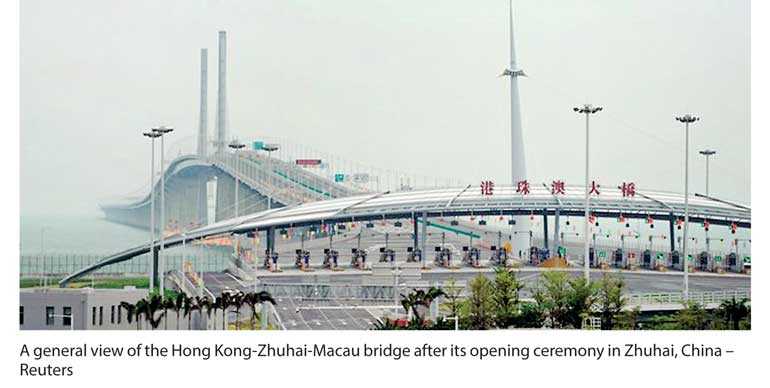Monday Mar 10, 2025
Monday Mar 10, 2025
Wednesday, 24 October 2018 00:00 - - {{hitsCtrl.values.hits}}
 HONG KONG (Reuters) - Chinese leader Xi Jinping opened one of the world’s longest bridges on Tuesday, during a tour to southern China that is seen by some as an opportunity for Beijing to reaffirm its commitment to economic liberalisation.
HONG KONG (Reuters) - Chinese leader Xi Jinping opened one of the world’s longest bridges on Tuesday, during a tour to southern China that is seen by some as an opportunity for Beijing to reaffirm its commitment to economic liberalisation.
The Hong Kong-Zhuhai-Macau bridge is made up of nearly 35-km (22-mile) bridge and road sections and a 6.7 km (4-mile) tunnel, and has been dubbed the longest “bridge-cum-tunnel sea crossing” in the world.
It will link the financial hub of Hong Kong to the relatively less developed western reaches of the Pearl River Delta in Guangdong province, as well as the former Portuguese colony and gambling hub of Macau.Xi said nothing during the inauguration of the bridge on Tuesday morning other than to declare it officially open to a burst of fireworks projected onto a screen behind him.
Hong Kong authorities have defended the bridge’s HK$120 billion price tag, saying it would consolidate Hong Kong’s position as a regional aviation and logistics hub.
Xi’s visit to the southern economic powerhouse of Guangdong had been shrouded in secrecy, with state media making little mention of his itinerary before he showed up for the bridge opening.
Some observers see Xi’s tour to the south as highly symbolic, coming on the 40th anniversary of the beginning of China’s reforms, when the country began a transformation from a centrally planned to a market-driven economy with “Chinese characteristics”.
Vice premier Han Zheng said the bridge would help drive China’s strategic blueprint for a “Greater Bay Area” around the Pearl River Delta modelled on other global economic dynamos like San Francisco Bay and Tokyo Bay.
“The bridge stimulates the interaction and trades between Guangdong, Hong Kong and Macao, facilitates the development of the Greater Bay Area and boost the comprehensive competitiveness of the Pearl River Delta,” Han said.
Some critics, however, see the bridge as a white elephant that is part of a multi-pronged push by China to exert greater control over Hong Kong, which returned from British to Chinese rule in 1997 amid promises to preserve the city’s high degree of autonomy and individual freedoms denied in mainland China.
The bridge was first proposed in the late 1980s, but it was opposed at the time by Hong Kong’s British colonial government, which was wary of development that might draw the city closer to Communist China.
The bridge’s opening comes at a challenging time for China as it faces pressure from a trade war with the United States, volatile financial markets, mounting public debt and a slowing economy.
Discover Kapruka, the leading online shopping platform in Sri Lanka, where you can conveniently send Gifts and Flowers to your loved ones for any event including Valentine ’s Day. Explore a wide range of popular Shopping Categories on Kapruka, including Toys, Groceries, Electronics, Birthday Cakes, Fruits, Chocolates, Flower Bouquets, Clothing, Watches, Lingerie, Gift Sets and Jewellery. Also if you’re interested in selling with Kapruka, Partner Central by Kapruka is the best solution to start with. Moreover, through Kapruka Global Shop, you can also enjoy the convenience of purchasing products from renowned platforms like Amazon and eBay and have them delivered to Sri Lanka.
Discover Kapruka, the leading online shopping platform in Sri Lanka, where you can conveniently send Gifts and Flowers to your loved ones for any event including Valentine ’s Day. Explore a wide range of popular Shopping Categories on Kapruka, including Toys, Groceries, Electronics, Birthday Cakes, Fruits, Chocolates, Flower Bouquets, Clothing, Watches, Lingerie, Gift Sets and Jewellery. Also if you’re interested in selling with Kapruka, Partner Central by Kapruka is the best solution to start with. Moreover, through Kapruka Global Shop, you can also enjoy the convenience of purchasing products from renowned platforms like Amazon and eBay and have them delivered to Sri Lanka.